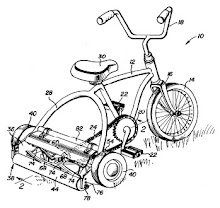When the Galaxy Nexus was first announced, tech wags speculated that its 118mm screen would just be too big and clumsy to handle. As a recent owner I can report that it is large but certainly not unwieldy. In a fit of house cleaning, I dug up my very first smartphone and thought it would be fun to post some pointless back-to-back size comparison shots.
The Samsung is just a bit narrower and shorter than the Handspring, but some of that width is accounted for by the Visor's elegant stylus. The big difference is in usable space: the Nexus is all screen, and a beautiful 720p HD screen with black blacker than blackest night at that. The Visor has a tiny monochrome screen with the rest of its face taken up by hard buttons and the graffiti writing area. (Hey - don't dis graffiti. One of the first things I did with my Nexus was to install a virtual graffiti keyboard.)
Flip them on their side and the contrast becomes more stark. Handspring was founded on the idea of "springboard modules", little hardware accessories that gave you an mp3 player or a camera or any of the other million things that our phones just take for granted these days. The Edge was meant to be the slimmest, sexiest of the Visor line so its springboard modules required an ungainly "shoe" that more than doubled the thickness of the device. The one and only springboard module I ever purchased was the phone add-on, which further had its own battery pack. From the side, this assemblage was a real porker. Still, it was kind of nice to be able to ditch the phone bulk when at the office and still walk around with a svelte little metal PDA.
It was my dream that someday I could have a phone with the form factor of the unadorned Visor Edge. There you go: 10 years later my Nexus is almost exactly the same size as that device. Progress!





While we're on the subject, it's worth noting that the 1999 Palm V is still the pinnacle of mobile device industrial design. IDEO knows how to build product.
ReplyDelete